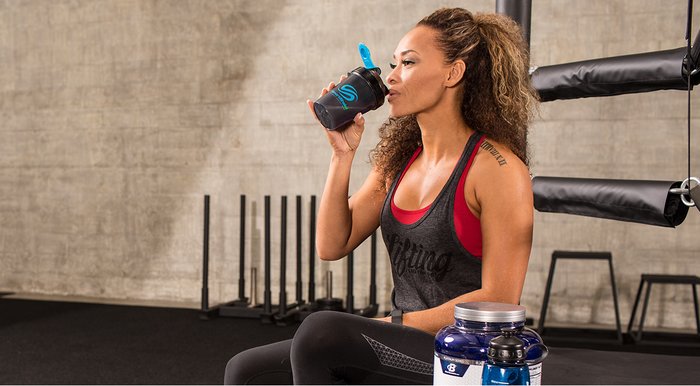When you're trying to lose weight, the idea of skipping breakfast before an early-morning workout might make sense at first. With no other energy source available, "training fasted" will make your body burn more fat, right? Yes, but it could also increase muscle loss and reduce overall performance, neither of which will help you lose weight in the long run.
Fortunately, there's another way. Instead of skipping breakfast and potentially causing muscle loss, you can eat in the morning and still lose weight! It all begins with doing one very important thing every morning: Eating protein before your workout.
Consume 20-30 grams of whey protein, chicken, lean meat, or deli meats, and your body will be ready to perform well and burn fat using either of the following two strategies.
Strategy 1: Learn How To Train "Low"
Training low refers to training with "low" levels of carbohydrates. When you consume carbs, your body breaks them down into sugars. These sugars either enter the bloodstream for immediate fuel (glucose) or are stored in the liver and muscles as glycogen to use for later. When you train low, your body relies on the carbs you stored overnight instead of on carbs you eat in the morning.
In fact, your body uses a significant amount of the glycogen (stored carbs) in your liver to maintain energy levels during sleep. With glycogen already in short supply, your newly awaked body has to start looking elsewhere for energy.

You might think your body would start using the glycogen stored in your muscles for fuel. But, no, it burns fat instead, meaning that you will still have ample glycogen stored in your muscles for your morning training.[1] To explain why your body chooses fat over muscle glycogen, we need to get into just a bit of science.
Your body prefers stored fats over stored carbs mainly because of two "signaling" proteins called AMPK and MAPK. They send messages around your body to start activities on a cellular level. These proteins have a powerful, positive impact on several factors that regulate how your body uses fuel during training adaptations. In effect, these proteins rev up the machinery in the cells responsible for using fat as fuel. Over time, this can lead to more fat burning!
So, if your body is ready to burn fats in a way that doesn't heavily impact its ability to build muscle, then you can have a normal workout, right? Not so fast. When you're on a low-carb diet, want to lose fat, and work out in the morning, you're better off focusing your morning routine on some form of cardiovascular training rather than lifting.
On the days when you aren't training low, focus on high-intensity exercise like Olympic movements, CrossFit, powerlifting, and high-volume bodybuilding splits. The higher the intensity of your training, the more your body relies on carbohydrate for fuel. Lifting big on low-carb days will compromise your performance.
Strategy 2: Use Medium-Chain Triglycerides to Your Advantage Pre-Workout
Beginning your day with a high-protein, low-carb meal also helps with weight loss, because it increases activity among enzymes responsible for breaking down stored fat. To explain how this works and the role medium-chain triglycerides (MCT) play in the process, it's back to the science books.
The enzymes adipose triglyceride lipase (ATGL) and hormone-sensitive lipase (HSL) work together to break down stored fat. First, ATGL breaks down fat stored (triglycerides) into a more usable form (diglycerides). Then, HSL kicks in to reduce diglycerides into even more usable monoglycerides.
When these fats are broken down, free fatty acids (FFA) become available. These FFAs serve as your body's fuel source during exercise and signal your body to make other changes that favor fat usage as fuel.[2]

But by adding MCTs to your breakfast, you can help your body skip one energy-intensive step. The MCTs found in coconut oil and dairy are helpful, because they're smaller than the large-chain triglycerides in foods like peanut butter, olive oil, or almonds.
Having a shorter "chain" means your body doesn't need to expend so much energy breaking down the triglycerides into diglycerides and then into the monoglycerides it needs for fuel. And the less energy your body spends on that process, the more it has left over to power your workout.
You can also get MCTs from supplements. Having too much of them in your system can lead to GI pain and diarrhea, so keep them in the range of 0.5-1.0 tablespoons (10-15 grams of fat total) and no more than 2 tablespoons (roughly 30 grams of fat) in one sitting.
And when you're thinking about how much MCT to take in, don't forget your daily calorie count. If you start the day by consuming lots of, say, coconut oil, you're getting calories with those MCTs. If you have to eat less later in the day to stay within your daily caloric limit, you might end up feeling hungry and add fat instead of losing it.
What Not to Do
Simple: Don't train fasted. Training while fasting was a staple in the bodybuilding realm for decades. But just because everyone was doing it—and, unfortunately, many still do—doesn't mean it's a good idea.

You can increase fat loss in the morning by carefully considering how you prepare for your pre-workout meal. With a breakfast high in protein, you can lower your carb intake or increase your fat intake to create the right conditions for achieving your goal, whether it's fat loss or muscle building.
It's important to note that you get the benefit of these diet choices only when you follow them consistently over a long period of time. Change will happen, but it won't happen overnight.
References
- Hulston, C. J., Venables, M. C., Mann, C. H., Martin, C., Philp, A., Baar, K., & Jeukendrup, A. E. (2010). Training with low muscle glycogen enhances fat metabolism in well-trained cyclists. Medicine and Science in Sports and Exercise, 42(11), 2046-2055.
- Philp, A., Hargreaves, M., & Baar, K. (2012). More than a store: regulatory roles for glycogen in skeletal muscle adaptation to exercise. American Journal of Physiology-Endocrinology And Metabolism, 302(11), E1343-E1351.



